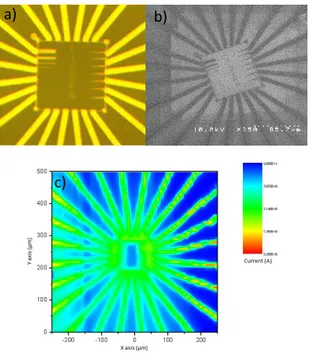HAL Id: cea-02349570
https://hal-cea.archives-ouvertes.fr/cea-02349570
Submitted on 5 Nov 2019HAL is a multi-disciplinary open access
archive for the deposit and dissemination of sci-entific research documents, whether they are pub-lished or not. The documents may come from teaching and research institutions in France or abroad, or from public or private research centers.
L’archive ouverte pluridisciplinaire HAL, est destinée au dépôt et à la diffusion de documents scientifiques de niveau recherche, publiés ou non, émanant des établissements d’enseignement et de recherche français ou étrangers, des laboratoires publics ou privés.
Mapping the electrocatalytic activity of N-doped
Carbon Nanotubes by Scanning ElectroChemical
Microscopy for oxygen reduction
Olivier Henrotte, Bruno Jousselme, Stéphane Campidelli, Vincent Derycke,
Renaud Cornut
To cite this version:
Olivier Henrotte, Bruno Jousselme, Stéphane Campidelli, Vincent Derycke, Renaud Cornut. Mapping the electrocatalytic activity of N-doped Carbon Nanotubes by Scanning ElectroChemical Microscopy for oxygen reduction. ELECNANO7, May 2016, Lille, France. �cea-02349570�
Poster - ElecNano7 - 23-25 may 2016 - Lille, France
Mapping the electrocatalytic activity of N-doped Carbon Nanotubes by
Scanning ElectroChemical Microscopy for oxygen reduction.
O. Henrotte a, B. Jousselme a, S. Campidelli a, V. Derycke a, and R. Cornut aa CEA Saclay, IRAMIS, NIMBE (UMR 3685), LICSEN, 91191 Gif-sur-Yvette, France
In this project, we use Scanning ElectroChemical Microscopy (SECM) [1] to investigate the
electrocatalytic activity of individual carbon nanotubes toward the oxygen reduction reaction (ORR) in acidic media as for Proton Exchange Membrane Fuel Cell (PEMFC). Our approach consists in displacing a nano-electrode in the vicinity of the nano-objects in order to acquire an image of their electrocatalytic activity.
To reach this goal, we first set up the fabrication of nano-electrodes. In order to detect the concentration in O2, we choose to work with gold probes, and to achieve a high spatial
resolution we decreased the size of the probe up to about 100 nm. The probes are then characterized by imaging a model substrate with motifs of different sizes (see figure), and further used to image sample where functionalized NTC are dispersed. [2]
Fig. 1: a) Optical microscopy image b) SEM image c) SECM image (done with 10 µm diameter gold electrode in FcMeOH 1mM and KCl 0.1M) of the
model substrate used to characterize the probes.
This methodology will permit to understand the origin of the achieved performances without any distortion due to the averaging of the response when working at the material level. We thus hope to understand the ORR mechanism with N-NTC and improve the state of the art methodologies for the synthesis of noble metal free electrocatalyst. This will contribute to make PEMFC more competitive.
[1] O’Connell, M. A.; Wain, A. J. Anal. Methods, 2015, 7, 6983− 6999.
[2] I. Hijazi, T. Bourgeteau; R. Cornut; A. Morozan; A. Filoramo; J. Leroy; V. Derycke; B. Jousselme; and S. Campidelli. J. Am. Chem. Soc., 2014, 136 (17), 6348–6354.
a) b)
